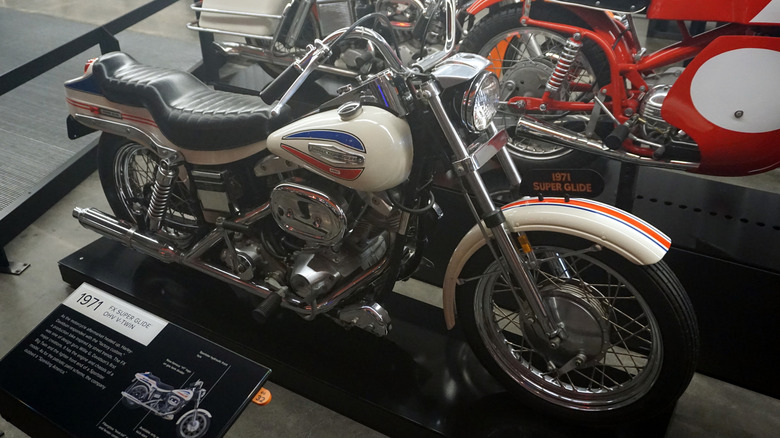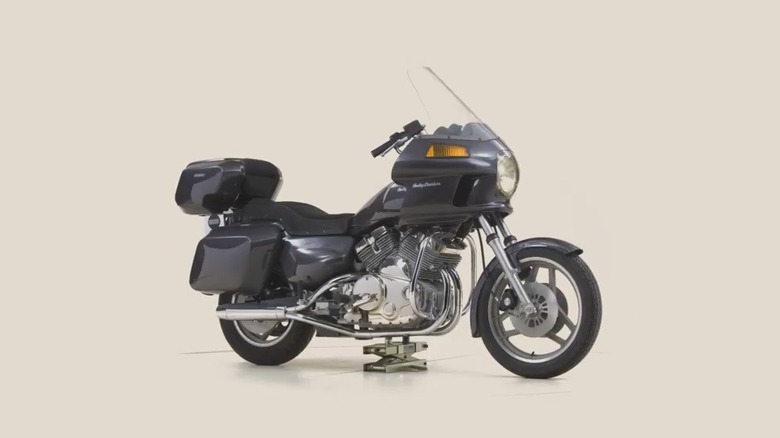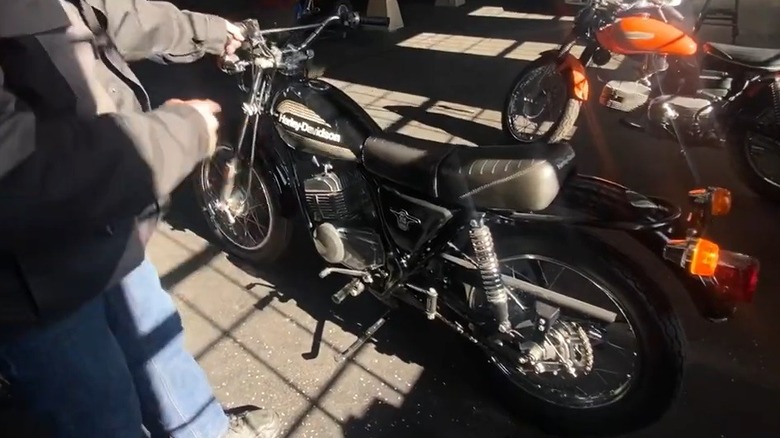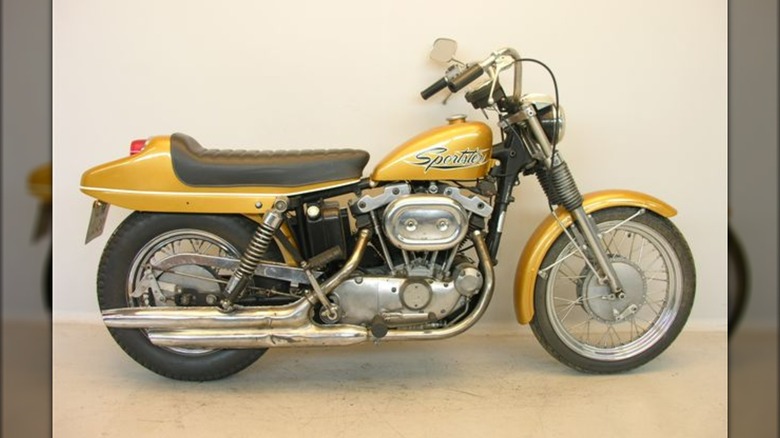Every Harley-Davidson Motorcycle Produced During The AMF Years
The history of Harley-Davidson motorcycles is as fascinating as it is lengthy. Established in earnest in 1903, the innovative William Harley and Authur Davidson quickly expanded their operation and a decade later were working out of a six-floor factory built on the company's newly acquired land. The brand grew quickly in size and prowess over the following decades, and even built roughly 80,000 motorcycles in direct support of the war efforts across the two World Wars.
However, another key occurrence in Harley-Davidson's vaunted story was a different sort of happening. In 1969, Harley-Davidson was bought by American Machine and Foundry (AMF), and this new brand, well known in the sporting goods world, took over production of the iconic American motorcycles (even venturing into other vehicular production like that of its snowmobile lineup). The partnership lasted until 1981 when AMF ultimately sold its ownership stake to a group of investors, including Willie G. Davidson (Arthur's grand-nephew).
The 1970s were a decade of tumult for motorcycle enthusiasts and for the American economy more broadly. AMF's buyout kept the brand afloat, but it came with plenty of controversy for H-D lovers. Bikes were manufactured overseas rather than at home to remain competitive with a flood of Japanese motorcycles entering the market, and production quality wasn't a strong suit of Harleys built in these years. Even so, a good few noteworthy Harleys were launched in the brand's 12-year stint with AMF at the helm, including the Low Rider, which remains in production today.
Harley-Davidson FX 1200 Super Glide
Potentially the best of the bunch, the FX 1200 Super Glide was rolled out in 1971 as a hybrid build combining elements of the Sportster and Electra Glide. It's sometimes referred to as the Boat Tail in deference to its back end shape. The bike is quite heavy, and oozes the look of customization, even as a production bike. The design was actually created by Willie G. Davidson, a decade before becoming an owner of the company. It's also a Harley that riders highlight as being quite inexpensive to maintain.
The FX 1200 Super Glide was heavy, with a wet weight just under 750 pounds, and delivered 65 hp through a potent V-Twin engine paired up with a four-speed transmission. It was a well-received addition to a long line of Harleys, and the company continued producing Super Glides in one form or another through 55 generations. It left production in 2013 with its final build coming as a Custom 110th Anniversary model powered along by a 1,584cc Twin Cam 96 engine.
[Featured image by Michael Barera via Wikimedia Commons | Cropped and scaled | CC BY-SA 4.0]
Harley-Davidson Nova
The Nova concept motorcycle was one of the AMF era's final designs. Produced in 1980 and 1981, the Nova would have been quite easy to miss considering that only three examples were ever delivered from the production floor. Working in partnership with Porsche, Harley-Davidson envisioned this concept bike with an 800cc four cylinder engine and water cooling. The V4 engine was built with 60-degree cylinder spacing, rather than the standard 45-degree layout. Its rollout was planned as a launch of six related Nova models featuring different power outputs and engine sizes in an effort to appeal to a wide range of current and future riders.
The lineup would have come ahead of other brands' V4 models, too, giving it a unique edge in this segment of the market. Unfortunately the project was scrapped and buried until a prototype model showed up on the floor of the company's Milwaukee museum many years later. The entire development cycle of the Nova product line was done in secret, and its rollout serendipitously coincided with the buyout of Harley-Davidson from AMF. After sinking over $10 million into the project during its development, the new ownership group opted to scrap the Nova in favor of designs that felt less risky from a financial standpoint.
Harley-Davidson SST 250 and SST 350 Sprint
The Harley-Davidson SST models were small yet capable machines. The SST 250 was built in 1977 and 1978, and the SST 350 Sprint was on the market in 1975 and '76. They weren't long-lasting bikes, but they filled a unique void in the Harley lineup. They also offered perhaps surprisingly good build quality, considering the general distain that riders have for the era of Harley-Davidson bikes in general.
In 1960, Harley-Davidson bought half of the Italian aircraft and motorcycle manufacturer Aermacchi, and worked with the brand to produce small bikes to gain entry into a growing segment of the market. In 1974, after being itself taken over by AMF, Harley-Davidson acquired the remainder of the Aermacchi brand and began rebadging its motorcycles directly as Harley-Davidsons. These bikes would go on to win small motor Road Racing World Championships in the 250cc and 350cc categories (250cc from 1974-1976 and 350cc in 1976). These motorcycles weren't in production for long, but they form an interesting divergence from the typical makeup of a Harley-Davidson and the SST 250 in particular was built with off-road capabilities in mind, perhaps for younger riders looking to get plenty of adventure out of their bike.
Harley-Davidson SX 125, SX 175, and SX 250
More Aermacchi models, the SX 125, SX 175, and SX 250 were all light motorcycles featuring small engine displacements (125cc up to 249cc) and zippy personalities. All three models entered the market in 1974 and only the SX 250 made it beyond a single year of production (exiting in 1976). All of these models featured air cooling and a two-stroke engine that made them agile and reliable, but not exactly powerful, as is the calling card of the Harley-Davidson brand.
Even so, the bikes were great for young riders just getting into the world of motorcycling. They were also some of the Harley lineup's most fuel efficient models ever to roll off the assembly line. This feature would have been prominently important in 1974 when the Aermacchi/H-D machines were unveiled, just months after the oil crisis of 1973 roiled the American driving landscape (and the wider economy, too). These bikes offered a fast and fun way to get around while providing a sort of guard rail against the potential for future oil embargoes or price increases at the pump.
Harley-Davidson SXT 125
The SXT 125 is the last of the Aermacchi crossover motorcycles badged in Harley-Davidson apparel. It's also a two-stroke off-roader built to handle rough racing terrain and the demands of youthful riders looking to put some pep in their step. The model features a small, 123cc engine and an air cooling system. This model ran from 1975 all the way up to the end of the partnership between Harley-Davidson and its Italian subsidiary in 1978. The bike is simple, which is what riders liked about it. The electronics and mechanical components weren't designed to turn heads, but rather deliver a sturdy ride and plenty of enjoyment on both road and trail.
The bike's small stature (weighing just 240 pounds, wet) delivered a bike perfect for the casual rider. The SXT 125's engine could produce 13 hp and was paired up with a five-speed transmission. The bike was never going to be a serious contender for Harley glory, but the uniquely clean and vintage swooping stripe of the AMF era's Harley logo combined with a lightweight frame and never-say-die two stroke powerplant make it a wonderful piece of Harley-Davidson history.
Harley-Davidson XLCR 1000 Cafe Racer
Only a handful of XLCR 1000 Cafe Racer models were ever produced (perhaps as few as 3,100). It's thought that Willie G. Davidson led the creation process to build a bike he wanted to use as his personal motorcycle, though that's never been confirmed. The bike exudes classic cafe racer aesthetics. It features trimmed down bikini fairings and a slim fuel tank, single rider's seat, and a twin-into-two exhaust system that adds a bit of flair to the rear portion of the vehicle.
The bike wasn't well received when it was released, but collectors have become far more interested in the XLCR in recent times, perhaps because of its relative rarity. The Cafe Racer was powered by a 997cc four-stroke V-Twin engine that was carbureted and air cooled. The bike could produce 68 hp at 6,200 rpm and 60 lb-ft of torque at a low end figure of 3,500 rpm for solid performance metrics across the board.
[Featured image by Yesterdays Antique Motorcycles via Wikimedia Commons | Cropped and scaled | CC BY-SA 3.0]
Harley-Davidson XR 750 and XRTT 750
The XRTT 750 entered the scene in 1972 and was built as a single-generation racing bike until 1978. Taking virtually its entire design from the existing XR 750 that debuted in 1970, the XRTT model was specifically designed for road racing events (in contrast to the XR 750's dirt track specialty). Both bikes have racing in their DNA and were established as Harley-Davidson's answer to Japanese and British racers that were dominating the motorbiking race landscape.
XRTT 750s were designed with an aluminum oil tank and a fiberglass fuel tank. Fiberglass elements were also used for fairings, including a heat shield to help dissipate this issue for a rider hunched down in a tuck position to take advantage of the full aerodynamic shaping of the bike. The XRTT 750 could achieve a top speed of 145 mph and a few examples remain in precious racing collections to this day (most notably Keith Cambell's, the owner of Hourglass Racing).
[Featured image by Mike Schinkel via Wikimedia Commons | Cropped and scaled | CC BY 2.0]
Harley-Davidson Low Rider (FXS)
The Low Rider is the only bike introduced during AMF's ownership period to survive all the way up to the present day (with models like the Low Rider S and Low Rider ST available now). Launched in 1977, the Low Rider was powered along by a 1,207cc four-stroke V-Twin with air cooling and carburetor feeding. The 1977 Low Rider produced 58 hp at 5,150 rpm and was known for agile maneuvering and solid power output. In its first full year of production the bike instantly rocketed up the charts to become Harley-Davidson's best selling motorcycle. Low Riders were based on the existing FL series frame (also featured in the Super Glide) and were classified themselves with the H-D code of FXS.
The bike's low seat (naturally, considering its name), teardrop shaped fuel tank, single, round headlight, and wide handlebar setup among other stylistic features made it instantly lovable, and today the bike still stands out as a sort of lightning in a bottle essence of what a Harley-Davidson is and represents stylistically. The FXS Low Rider was a frontline product for AMF-owned Harley-Davidson, and the company made only small tweaks to the motorcycle's design language throughout its time under the AMF banner. 1980 saw a larger engine introduced (1,337cc, producing 67 hp at 5,800 rpm), and from there changes came with greater regularity once ownership officially changed hands.
Harley-Davidson XLCH Sportster 900 / XLCH / XLH Sportster 1000s
The Sportster is one of Harley-Davidson's most beloved motorcycles. Launched in 1967, a few years before the AMF purchase, the Sportster 900 featured a 45-degree V-Twin with air cooling and a four-stroke, 883cc engine. It packed in dual shocks for the rear suspension and a drum braking system among other tools found standard on high quality cruisers.
The Sportster would continue through numerous generational improvements, boosting engine displacement for the 1972 model year to 997cc (in the XLCH Sportster 1000), though the general specifications remained largely the same through the AMF years.
One big change was a slight drop in peak horsepower through the larger engine, but with max output coming at a lower engine speed for more low end power (60 hp at 6,800 rpm compared to the 1000 model's 55 hp at 5,800 rpm). As well, disc brakes were favored from 1973, and in the 1978 model year the bike was reclassified from an XLCH code model to the XLH Sportster 1000. The change, according to Harley owners, denotes the addition of an electric starter.
Minor stylistic tweaks were introduced throughout the remaining AMF years, with a change to using Showa forks and shocks, as well as a backrest for the pillion rider coming right as ownership was changing over. The Sportster didn't begin life as an AMF creation, but it continued through the era, and remains a modern staple.
[Featured image by Yesterdays Antique Motorcycles via Wikimedia Commons | Cropped and scaled | CC BY-SA 4.0]
Bicentennial Liberty and Confederate Harley-Davidsons of 1976 and '77
Perhaps the most infamously negative decision in Harley-Davidson's long history of motorcycle design, the brand, under AMF ownership, opted to follow up a bicentennial edition of its livery with a confederate flag design the next year. Neither bike was a new take on motorcycle design, but rather a stylization of existing models to give riders a kind of limited edition feel (like the Bumblebee Camaro stylized with Transformers logos or the "Call of Duty"-styled Jeep Wrangler of recent memory).
The Bicentennial Liberty Edition was well received by motorcyclists and by all accounts helped infuse new interest in the brand and its lineup. It featured additional decals celebrating the iconography of American history. The confederate stylization, on the other hand, led to a civil rights complaint that halted production with roughly 650 completed units. The confederate bikes feature a silver paint job with subdued H-D and AMF logos alongside an unmistakable confederate flag and a few other choices to mimic the aesthetics of a confederate uniform. Suffice it to say, the Sportsters, Electra Glides, and Super Glides that received the ill-advised livery treatment have faded quickly into history, marking a curt chapter that Harley-Davidson would likely rather forget.










